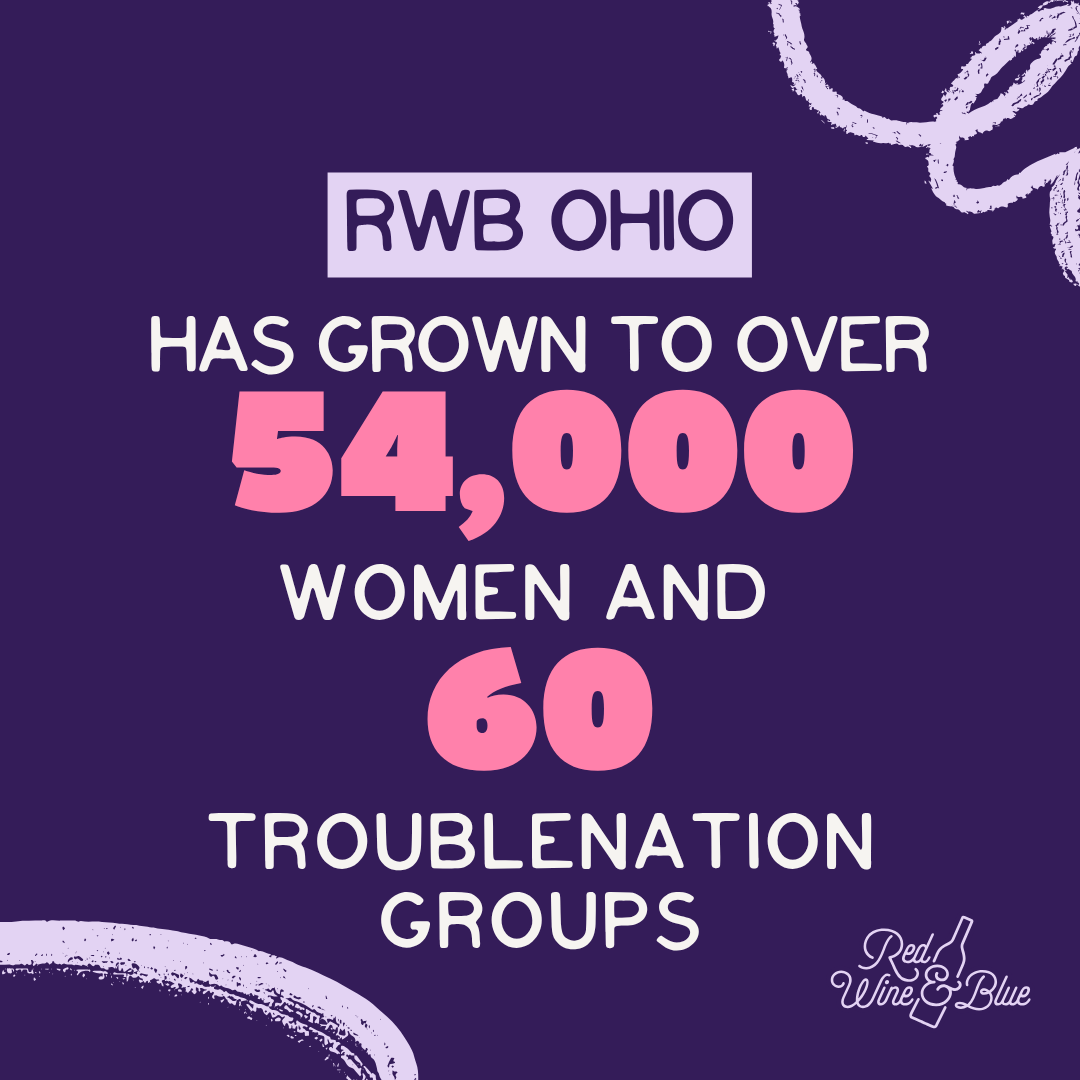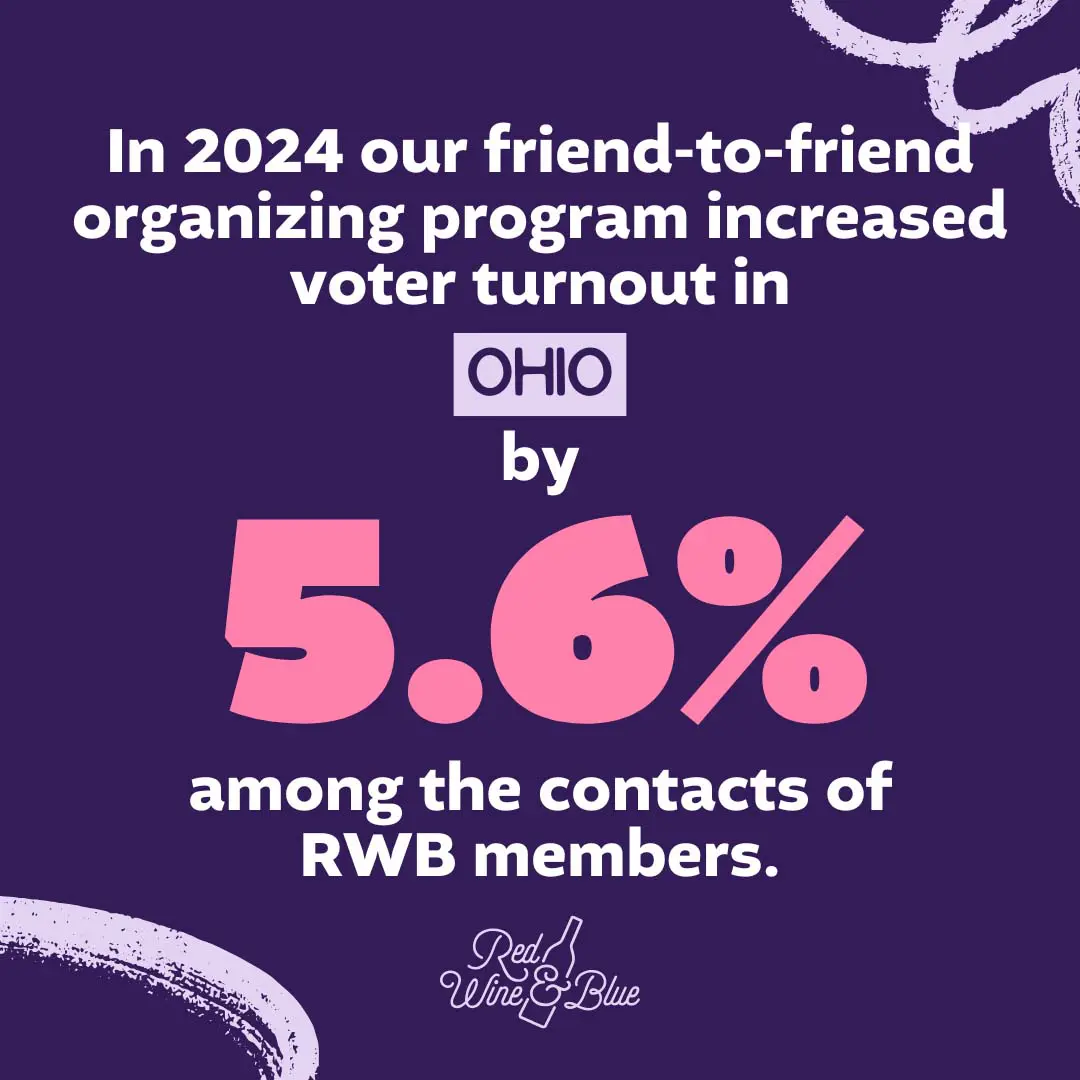
Welcome to Red Wine & Blue Ohio
We’re a community of more than 54,000 Ohioans and 60 TroubleNation groups standing up to extremism in our state. Our team of Regional Organizers works across Ohio to connect our members and groups with resources and actions to fight extremism at the local and state levels.
With all the chaos happening at the federal level, we’re staying laser focused on where we know we can have the most impact — right here at home! We’re using friend-to-friend organizing to make sure everyone in Ohio knows what’s at stake in 2025. Because when they go low, we go local. That’s how we win.
Making a Difference In Our Hometowns
Our RWB Ohio team works hard to empower, train, and mobilize women in every part of our state. We host virtual statewide events and a variety of local in-person events for all of our troublemakers.
Our strength comes from our members — organizing in your community, educating neighbors, and bringing friends and family into the fight against extremism with us.



Just look at how powerful friend-to-friend organizing is! We’ve added common sense candidates to both chambers of the Ohio Statehouse. By staying vigilant, we’ve also worked to protect reproductive freedom and rights for Ohio families. We need to keep showing up in 2025 to protect public education and elect common sense school board members to keep schools safe and welcoming.
Ready to make a difference in your town?
Find your local group. Or start one of your own.
What’s At Stake in Ohio in 2025
We won’t allow extremists to take over our communities. We will advocate for the issues that matter to us, and we will protect our rights up and down the ballot. Click on each issue below to learn more.
Access to Reproductive Healthcare
All Ohioans deserve to have the freedom to make choices regarding their bodies, and we will continue to advocate for bodily autonomy for everyone in our state.
Many of the state laws impacted by the reproductive rights ballot initiative we passed in 2023 are winding their way through the courts. They will likely head all the way to the Ohio Supreme Court. We’ll keep you informed by sharing updates about any legal decisions made in Columbus that impact our reproductive freedom.
We’re also working with our coalition partners to share resources about how the recently passed bathroom bans will be enacted in our schools.
Public Education
Public education is under attack in Ohio. From the budget fight and expanded private school voucher funding to the passing of legislation that will impact diversity, equity and inclusion from kindergarten to grad school — extremists are trying to defund and reshape public schools. We’re working with our coalition partners to help you understand how these policy changes will impact your local districts.
Being informed about who is currently serving on your school board and what decisions are being made is a great first step to make sure that you’re ready to vote in November. With our Rally tool, you’ll be able to easily share information with your friends and family to make sure they understand the importance of these local school board races.
Right now, we’re taking action by helping to gather signatures for a ballot referendum to roll back the Higher Education Destruction Act (SB 1) that was pushed quickly through the legislature in early 2025 and signed by Governor DeWine.
Voting Rights
We’ve all watched as extremists in Columbus have created barriers to voting for so many Ohioans. Whether it’s ID requirements or changes to the way you can return absentee ballots, they’re making it more challenging every year to make sure our voices are heard on Election Day. That’s on purpose and it’s all about control.
We know that decisions made by our local elected officials affect our families every day. Together, we can make sure our friends & family members understand the importance of voting in all local elections to keep these extremists from taking away our rights.
By using our Rally tool, you can share helpful voting information to make sure that everyone in your network has the opportunity to cast their ballot.
Fair Maps
For years, political insiders in Ohio have created voting districts that favor extremist politicians, who can continue creating even more unfair districts. This is all designed to keep themselves in power, regardless of what (and who) voters want and is called gerrymandering.
When gerrymandered districts exist, politicians get to choose their voters by drawing unfair voting district maps. Our gerrymandered districts allow extremist politicians to stay in power, despite not representing the values of their constituents. Let’s decide who represents us instead of the other way around.
We tried to correct our gerrymandered districts last year with Issue 1, but it didn’t pass. This year, we can still put pressure on our elected representatives and the commission for maps. The legislature has until the end of September 2025 to pass a new map with three-fifths support in both chambers, or the Ohio Redistricting Commission will take over to adopt a plan by October 31, 2025. We’re telling them to create maps that represent ALL of Ohio!
Meet Your RWB State Ohio
Get involved with RWB Ohio
When you sign up to receive emails from us, you’ll receive our weekly newsletter with details about all Red Wine & Blue events, along with updates about what’s happening in Columbus. We’re all about helping you make meaningful connections so you can organize in your community.


